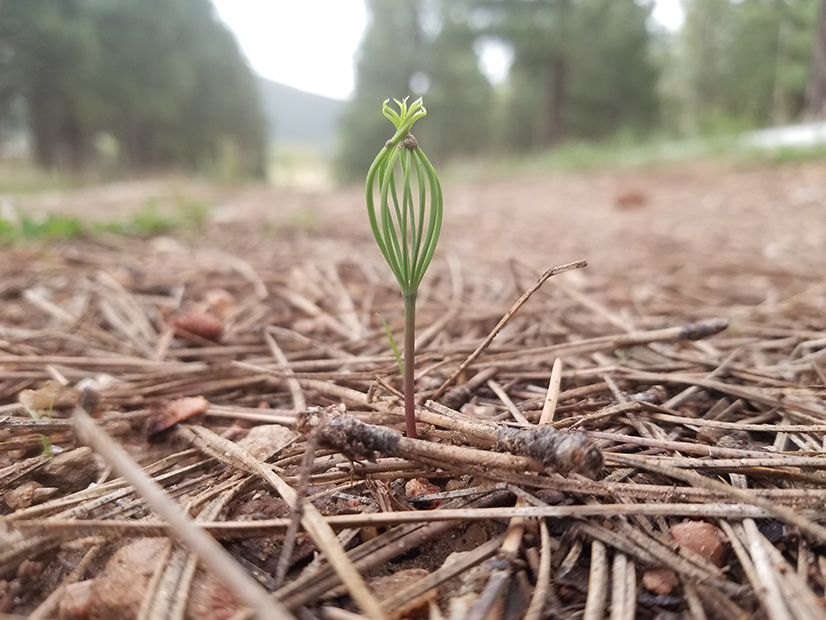
Partners in a recently formed New Mexico Reforestation Center are seeking roughly $80 million in federal funding to reach the goal of producing 5 million seedlings a year to plant in wildfire burn areas.
The Reforestation Center was created in January through an agreement among the New Mexico Energy, Minerals and Natural Resources Department (EMNRD) and three state universities: New Mexico Highlands University, New Mexico State University and University of New Mexico.
Two bills in the New Mexico legislature this year — HB101 and SB145 — would have allocated $4.6 million to the Reforestation Center. Neither bill passed.
The center’s collaborators now plan to apply for a federal grant to fund their activities.
The U.S. Department of Agriculture in February announced $1 billion in funding through its Partnerships for Climate-Smart Commodities opportunity. The funding is offered to farmers, ranchers and forest landowners to implement climate-smart production practices on working lands. Recipients are asked to quantify the greenhouse gas benefits of those practices and develop markets for the resulting climate-smart commodities.
Proposals ranging from $5 million to $100 million will be considered in the first funding pool. The application deadline is April 8.
Growing Capacity
The state needs more than 300 million seedlings for a backlog of burned areas, according to EMNRD, but the current tree nursery capacity is 300,000 seedlings per year.
The New Mexico Reforestation Center’s goal is to grow 5 million seedlings per year. And the seedling production will be “climate smart,” to increase the odds that trees planted now will survive in future climate conditions.
“The new Reforestation Center will increase the number of acres planted each year, which in turn contributes to healthy watersheds and climate change resiliency,” EMNRD Secretary Sarah Cottrell Propst said in a release.
Joshua Sloan, associate vice president of academic affairs, Forestry and Reforestation Center at New Mexico Highlands University, told NetZero Insider that two steps are being taken to produce climate-smart seedlings.
The first is to collect seeds from trees that, through natural selection, have shown that they can handle heat and drought.
The next step focuses on how the seedlings are grown. Rather than watering them regularly, Sloan said, water is limited so that the seedlings begin to adapt to drought conditions. The idea is to prevent the transplant shock that seedlings grown in conventional ways often experience.
In another part of the project, researchers at the University of New Mexico will be working on forest climate modeling and quantifying carbon capture by trees.
“Every seedling we put on the landscape is a carbon sink,” Sloan said.
The Reforestation Center also includes a workforce development component.
“A skilled forestry workforce is necessary to plant the seedlings grown by the Reforestation Center,” New Mexico Highlands University President Sam Minner said in a statement. “Our students and faculty will be training the next generation of tree planters and foresters.”
Funding Sources
The reforestation team is still working on its application for USDA funding, but Sloan said the request would likely be for about $80 million. The funding would cover the costs to build the new, high-capacity nursery and keep it running for five years.
Meanwhile, Sloan said, the reforestation efforts have received some smaller contributions, including a private donation and in-kind support. The funds are enough to jump-start the seed collection project, he said.
Although the bills requesting $4.6 million for the Reforestation Center failed, the state legislature approved an $80,000 annual appropriation to EMNRD for reforestation projects, department spokeswoman Susan Torres said.
The legislature also approved a new full-time reforestation coordinator in EMNRD’s Forestry Division. The employee will be responsible for statewide seed collection and planting coordination.
Statewide Strategies
Reforestation is one of 10 strategies outlined in New Mexico’s Forest Action Plan, and it’s also discussed in the state’s 2020 Climate Strategy.
“Our forests, grasslands, and agricultural lands have a large part to play in absorbing CO2 as we work towards fewer emissions,” the climate strategy said in a section on natural and working lands.
The climate strategy calls on the Forestry Division to develop a plan for incorporating drought-tolerant plants in reforestation efforts. In addition, the division will use research on wildfire burn areas to identify microsites where seedlings are more likely to survive.
The approaches to tree-planting will be shared with other state divisions and agencies. For example, EMNRD’s Mining and Minerals Division could use the Forest Division strategy in its mine reclamation reforestation work.